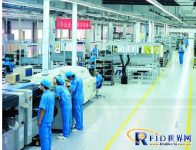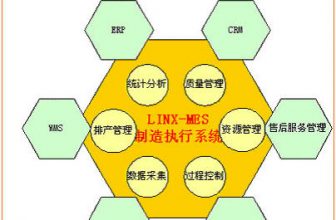
Production process management system based on RFID technology
[ad_1]
1. Background
With the development of economic globalization, traditional intensive processing and manufacturing industries, such as clothing, electronics and other industries, have higher and higher single-product manufacturing costs and lower and lower processing profits. In order to improve the overall profit rate of the enterprise and optimize the management of the enterprise Process, through information transformation to improve production efficiency has become one of the effective means.
In the production process of traditional manufacturing enterprises, most of the production modes are based on the one-piece production mode. The biggest disadvantage of this production line mode is that there is usually a large backlog of semi-manufactured products in some bottleneck processes. If the process is complicated and With more production links, this phenomenon will become more serious.

At present, the following problems generally exist in the management of traditional processing enterprises:
1) The overall production efficiency is low, and on-site management is impossible;
2) The amount of data in the production process is large, and the backlog of the production line is serious, and automatic circulation and automatic data collection cannot be formed;
3) A large amount of data needs to be manually entered, the accuracy and work efficiency are low, and the reliability cannot be guaranteed;
4) Poor controllability, inaccurate control of the processing schedule, and insufficient ability to monitor the status of the production site;
5) The quality loss is serious, the repair rate is too high, and the quality can not be traced;
6) The production schedule of the order, the work-in-process and completion data of the workshop are not clear, and the cost cannot be calculated accurately;
7) The analysis and statistics of business data cannot be accurate and timely, and it is difficult to dig out valuable information to guide future production plans.
Mass data is generated in all aspects of the business process of an enterprise, including product production, demand management, customer relationship management, planning, supply, raw material procurement, production, warehouse management, distribution and finance, and even every corner of the enterprise. How to obtain these data in real time, centrally process and analyze these data, will be the key to winning this data war.
We use EPR production process management assistance system toRFIDAs an information carrier, electronic tags can obtain data from all directions through wired information channels and process them in real time. Record the whole process of each link of the entire enterprise business process, realize the automatic identification and real-time management of the work-in-process, so as to realize the real-time tracking of the product life cycle, and improve the work efficiency and service level of the enterprise’s production management.
The whole process management system is divided into software management system and data acquisition system. The production information on the production line is collected through the data acquisition system, sent to the database for processing, and the production process is monitored through the software management system. It is a part of EPR (Enterprise Resource Planning) and assists EPR to complete the entire process.
2. Software Management System
Through the production process management auxiliary system, enterprise managers can know the real-time production status of the enterprise at any time, the quantity and status of the product parts and components produced, the demand and inventory of raw materials, purchased parts, and accessory parts, and the inventory of work in progress and finished products. Situation, inventory of raw materials, work-in-process, and finished product capital occupation, etc., and can quickly generate relevant data, greatly improving the efficiency and accuracy of management work. The actual application of the production process management system software is the foundation of the modern management of an enterprise, and it is also an effective means that can truly enable the enterprise to see the effectiveness of management.
2.1 Software design function
The software is a set of practical production management system designed based on the design concept that fully conforms to the actual management process of the enterprise, takes production management as the core, and realizes production logistics, product cost, production capital, comprehensive statistics and other management objectives through the computer. Fully consider various possible situations, and carry out automatic processing, so that the whole system has the characteristics of strong practicability, good stability, high degree of automation, simple and clear interface, easy to learn and easy to use. It is an ideal production management system that is very suitable for processing and manufacturing enterprises.
According to the actual production management process, the system includes important functional modules such as technology management, production management, raw material management, work-in-process management, cost management, and comprehensive statistical query.
1. Technical management: display the hierarchical structure of the product according to the ownership of the parts and components, and realize the compilation and management of product schedules, process cards, and blanking cards. The structure is clear, the operation is flexible, and the function is comprehensive.
2. Production management: compile or import the product details to be put into production from the sales order, and automatically generate the production parts, component details, raw materials, standard parts, supporting parts demand details, and outsourced processing order details, etc. It can print material requisition forms, production dispatch work tickets, various production plans, etc. In the calculation process, the inventory can be automatically checked, the available parts in stock can be deducted from the production quantity, and the new production quantity in the production batch and the existing inventory quantity can be recorded.
3. Process control: By entering the completion information of each processing procedure, the processing progress of product parts and components can be tracked, and the production status and completion rate of each production batch of parts and components can be inquired.
4. Raw material management: including production raw materials, standard parts, purchased parts, etc. Provide a convenient and flexible material coding system to ensure the standard and uniform use of materials; a perfect inventory management system, which organically combines the management of materials with the production system, and effectively controls the use and distribution of materials. Inventory upper and lower limit settings can well control inventory backlog and capital occupation. There is an essential difference between the material inventory management of the production enterprise and the commercial inventory management. When the raw materials in the production enterprise go out of the warehouse, no sales records and accounts receivable are generated, but they are converted to work in process or finished products after additional processing costs. The cost is also converted to the material cost of the corresponding finished product. Therefore, many commercial inventory management software are pure inventory management software that is separated from production management, and can only simply replace manual accounting, and cannot solve the fundamental problem of material control and management in the enterprise.
5. Work-in-process management: unified management of inventory work-in-process, workshop work-in-process, and outsourced processed parts. All parts are connected with each other to effectively control production logistics.
6. Finished product management: Comprehensive management of finished product inventory and sales. It can count the inventory of each finished product at any time, the quantity in and out of the warehouse, and the amount.
7. Cost management: The production cost of a product includes two parts: material cost and production man-hour expenses. The system can calculate the planned cost of materials, actual costs and labor costs according to conditions such as products, parts, components, production batches, and a given time period. It can complete the accounting of various production funds; realize the management of sales orders, receivables, and accounts payable.
8. Comprehensive statistical query: It can realize the data statistics of all the above management contents, automatically generate related reports, and can independently set the print format of all reports.
Third, the realization of real-time data acquisition system
The real-time data acquisition system can solve the problems of insufficient ability to monitor the status of the production site, poor coordination between stations, lack of effective guidance for on-site operations and ingredients, and lag in quality data entry. The production line management system based on RFID technology has become an effective solution to the above-mentioned problems.
3.1 RFID real-time data collection
By adopting RFID technology, the system can automatically collect production data and equipment status data, and provide real-time data of all links in the business process for production managers. Online monitoring and analysis of production information such as process parameters and equipment operating parameters in important links of production help companies realize the measurement of semi-finished and finished processes in the production process, the automation and information integration of warehouse warehousing management, and the automatic real-time of the supply chain Tracking, sales and after-sales service feedback, so that business leaders can grasp process information in real time, and supervise and supervise business operations.
RFID can provide a constantly updated real-time data stream. Complementing the manufacturing execution system, the information provided by RFID can be used to ensure the correct use of labor, machines, tools, and components, thereby achieving paperless production and reducing downtime. Furthermore, when materials, parts and assemblies pass through the production line, the production process can be controlled, modified and even reorganized in real time to ensure reliability and high quality.All data is collected by the client computer at high speed through wireless
[ad_2]




